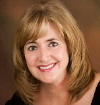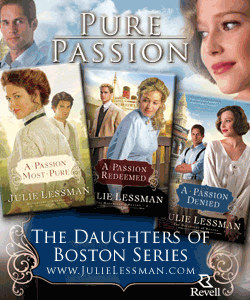 Julie Lessman is a new author who has garnered much writing acclaim, including ten Romance Writers of America awards. She resides in Missouri with her husband and their golden retriever, and has two grown children and a daughter-in-law. She is the author of The Daughters of Boston series, which includes A Passion Most Pure, A Passion Redeemed, and A Passion Denied. You can contact Julie through her Web site at www.julielessman.com. |
|
CONFESSIONS OF AN HISTORICAL
AUTHOR . . .
|
|
|
“But I don’t write ‘historicals,’” I said stupidly to my agent. “I write romance.” Uh, wrong. And, yes, I was that green of a writer, one who actually didn’t consider the historical aspect of my story as important as the emotional tug-of-war between the hero and heroine. I mean, come on now, everybody knows the most important thing is what happens in the story not when it happens, right? Wrong again, a lesson I learned the hard way, which is my usual mode of study, apparently. I can still see the twelve two-sided pages of feedback my critique partner gave me on A Passion Most Pure, my debut novel in The Daughters of Boston series—simple little things that may have been nitpicky to me but were deadly to the historical accuracy and feel of my story. “Julie, the chocolate chip cookies Mrs. Gerson serves in chapter seven sound good, but this is 1916, and chocolate chips weren’t invented until 1939.” And the worst offense of them all, a blunder that almost derailed my plot completely, got past me, my critique partners, and my editor. A huge mistake caught, ironically, by my editor’s husband, who happened to be—what are the odds?—an Irish historian! He innocently pointed out to his wife that the O’Connor’s traveling on a ship to Ireland during World War I would not have been feasible because passenger ships at that time were commandeered for war. Not to mention the annoying fact that German U-boat warfare made it too dangerous for ship travel. Sigh. That was the day that I learned just how important research is to an historical romance, and it is a lesson I hope and pray I have learned well. Fortunately for me, after a little sobbing, a lot of praying, and tons more detailed research, I found a perfectly acceptable solution that allowed me to transport the O’Connors from Boston to Dublin during WWI in a totally believable way. Thank you, God! So, how does somebody like me who despises research tackle the job of ensuring that the setting, speech, hairstyles, clothing, mannerisms, appliances, music, movies, and the like are good enough to transport readers to the characters’ era? Very carefully. For me, it begins with browsing the Internet for clothing and hairstyles so I can get the look of the characters firmly in mind, for both me and the reader. I usually catalog the best Web sites I find, either by bookmarking them as a “favorite” on my browser if I intend to use them a lot, or pasting the link in an “Historical Research” document that I create for each book. One, of many, of my favorite Web sites for clothing and hairstyles is http://www.fashion-era.com/index.htm. Next, I look at historical timeline Web sites, again gleaning as much fascinating detail as I can to infuse the book with the look and feel of the era. For instance, in my next series, which will |
release in 2010, I follow the last three O’Connor siblings through the Roaring Twenties and into the Great Depression, the latter not a particularly appealing time. But through my research, I am able to jazz up the story with lots of interesting people and things that will help readers not only to easily identify the era, but to relate to it as well. Speakeasies, dance marathons, and colorful historical characters such as Eliot Ness, Bonnie and Clyde, and John Dillenger will add depth and dimension to the book, not to mention a splash of historical color. Although you can Google timelines galore, one I have used with success is http://timelines.ws/ Undoubtedly, the most fun I have with research is the etymology of words, which Merriam-Webster defines as “the history of a linguistic form (as a word) shown by tracing its development since its earliest recorded occurrence in the language where it is found.” As an historical writer, I have to make absolutely sure that the words and slang my characters use typify or even qualify for the era for which I am writing. To this end, I would be absolutely lost without the Online Etymology Dictionary, http://www.etymonline.com/, an exceptional resource that tells if a certain word was used during the era I’m writing about. And since slang is essential to natural dialogue, I always research slang sayings and phrases through favorite Web sites such as http://www.answers.com/. Finally, as I write, I research various things like automobiles, telephones, and appliances to make sure they were available then and how they worked. I usually just do a Google search on the item. One Web site I’ve used for appliances is http://www.oldandinteresting.com/, and another good general Web site that touches on several historical items is Charlotte Dillon’s “Research Links for Writers” at http://www.charlottedillon.com/ResearchLinks.html. Ironically, as I am writing this article, my critique partner just called to give me a progress report on the first book of my new series, which she read to catch the historical blunders I no doubt made,. And you guessed it—she nailed me again. “Julie, when Katie is typing, she can’t ‘push the return key with a focused glint in her eye’ because it wouldn’t be a key, it would be a lever, right?” Sigh. “Key,” “lever”—who really cares? Well, when you’re talking historicals, the reader does, apparently . . . and now, so do I!  |
|
|
|
|
|
|







